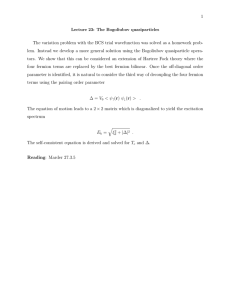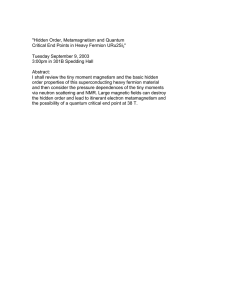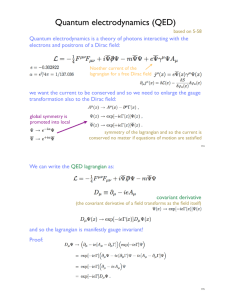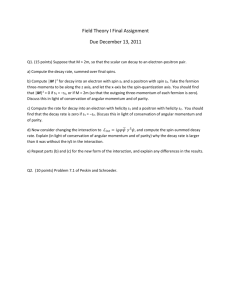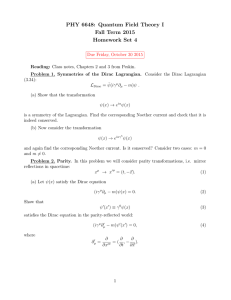Final Exam Phy 781 - Spring 2016
advertisement
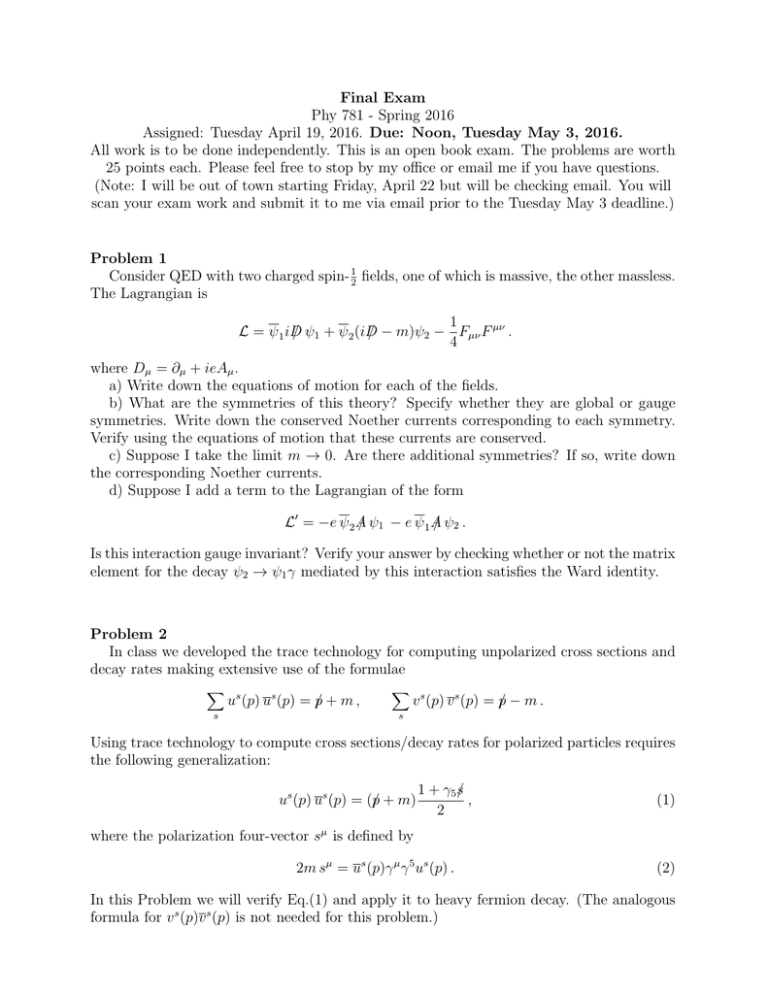
Final Exam Phy 781 - Spring 2016 Assigned: Tuesday April 19, 2016. Due: Noon, Tuesday May 3, 2016. All work is to be done independently. This is an open book exam. The problems are worth 25 points each. Please feel free to stop by my office or email me if you have questions. (Note: I will be out of town starting Friday, April 22 but will be checking email. You will scan your exam work and submit it to me via email prior to the Tuesday May 3 deadline.) Problem 1 Consider QED with two charged spin- 12 fields, one of which is massive, the other massless. The Lagrangian is 1 / ψ1 + ψ 2 (iD / − m)ψ2 − Fµν F µν . L = ψ 1 iD 4 where Dµ = ∂µ + ieAµ . a) Write down the equations of motion for each of the fields. b) What are the symmetries of this theory? Specify whether they are global or gauge symmetries. Write down the conserved Noether currents corresponding to each symmetry. Verify using the equations of motion that these currents are conserved. c) Suppose I take the limit m → 0. Are there additional symmetries? If so, write down the corresponding Noether currents. d) Suppose I add a term to the Lagrangian of the form L0 = −e ψ 2 A / ψ1 − e ψ 1 A / ψ2 . Is this interaction gauge invariant? Verify your answer by checking whether or not the matrix element for the decay ψ2 → ψ1 γ mediated by this interaction satisfies the Ward identity. Problem 2 In class we developed the trace technology for computing unpolarized cross sections and decay rates making extensive use of the formulae X s us (p) us (p) = p/ + m , X v s (p) v s (p) = /p − m . s Using trace technology to compute cross sections/decay rates for polarized particles requires the following generalization: us (p) us (p) = (/p + m) 1 + γ5 /s , 2 (1) where the polarization four-vector sµ is defined by 2m sµ = us (p)γ µ γ 5 us (p) . (2) In this Problem we will verify Eq.(1) and apply it to heavy fermion decay. (The analogous formula for v s (p)v s (p) is not needed for this problem.) a) First verify that the four-vector sµ defined in Eq. (2) is the polarization vector of a spin- 21 particle by showing that in the rest frame of the fermion, pµ = (E, p~) = (m, ~0), the time-component of sµ vanishes and space components are a unit vector pointing in the direction of the fermion spin. For example, if in the rest frame the fermion has sz = ±1/2 then the four vector sµ = (st , sx , sy , sz ) = (0, 0, 0, ±1). b) Bilinears that can be constructed from us (p) and us (p) are us (p)us (p) us (p)γ µ γ5 us (p) us (p)γ µ us (p) us (p)γ5 us (p) us (p)σ µν us (p) = = = = = 2m 2m sµ 2pµ 0 2µναβ sα pβ . (3) The first equation establishes the normalization of us (p) and the second defines sµ . Use the Dirac equation to verify the last three identities in Eq. (3). c) Argue using the completeness of the gamma matrices that us (p)us (p) can be determined in terms of the bilinears in Eq. (3). Verify Eq. (1). d) Consider a theory with a heavy fermion, ψ2 , of mass m, and massless fermion, ψ1 , and a scalar, φ, with mass mφ (< m). These particles are coupled by the interaction Lagrangian L = gψ 2 1 − γ5 ψ1 φ + h.c. . 2 Calculate partial width for the decay ψ2 → ψ1 φ as well as the angular distribution 1 dΓ , Γ d cos θ where cos θ is the angle between the polarization vector of ψ2 and the direction of the ψ1 three-momentum. Can you explain your result for the angular distribution by considering the angular momentum of the inital and final states and applying elementary quantum mechanics? Problem 3 Consider the following theory of two scalar fields 1 1 1 λ L = (∂µ φ1 )2 + (∂µ φ2 )2 + m2 (φ21 + φ22 ) − (φ21 + φ22 )2 . 2 2 2 4! Notice the mass term has the wrong sign. This means that the classical vaccuum is not φ1 = φ2 = 0 but φ21 + φ22 = v 2 , v 6= 0. a) Sketch the vaccuum energy as a function of v and find the value of v that minimizes the energy. In cases like this we must expand the fields around the true ground state. Define φ1 = v + ρ, φ2 = π and rewrite the Lagrangian in terms of the fields ρ and π. What are the masses of the fields ρ and π? One should be massless. b) Write down all the Feynman rules for this theory (in terms of the fields ρ and π). c) Calculate the scattering amplitude for ππ scattering to lowest order in perturbation theory. You should find that the amplitude vanishes as the external momenta of the π goes to zero. Problem 4 In this problem you will use field theory methods to solve a nonrelativistic quantum mechanics problem. Consider a particle of unit mass moving in one-dimension in a potential that is the harmonic oscillator potential plus small anharmonic corrections. The Lagrangian is 1 1 L = ẋ2 − ω 2 x2 − gx3 − hx4 . 2 2 Treating the anharmonic terms as a perturbation, the shift in the ground state energy to lowest order in g 2 and h is given by ∆E = 3h 11g 2 − . 4ω 2 8ω 4 You will reproduce this result by treating this system as a field theory in zero space and one time dimensions. The propagator for the x field is i/(k 2 − ω 2 + i), where k is now a “onemomentum” (energy) rather than a four-momentum. For each loop you must integrate over dk/2π rather than d4 k/(2π)4 . Feynman rules for the vertices are the same as 3+1 dimensional field theory and there are no UV divergences so you do not have to worry about renormalization. The shift in the ground state energy is given by a formula analogous to Eq. (4.56) of Peskin. There are three vacuum diagrams that contribute to the O(h, g 2 ) correction in Eq. (4). One requires a evaluating a genuine two-loop integral which I will do for you: dp dk i i i 2 2 2 2 2 2π 2π p − ω + i k − ω + i (p + k) − ω 2 + i Z dpE dkE 1 1 1 = −i 2 2 2 2 2π 2π pE + ω kE + ω (pE + kE )2 + ω 2 −i = . 12 ω 4 I2 = Z The first step is the Wick rotation and the second integral can be done by repeatedly using the residue theorem.
